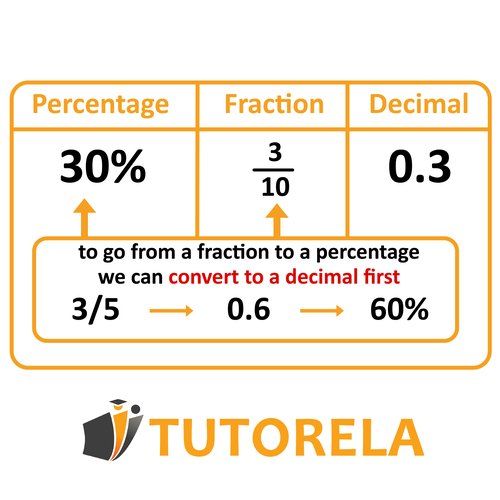In order to convert between fractions and percentages and vice versa, it's important to remember that one percent - .
If you remember this principle, the calculations are simple.
Converting Fractions to Percentages Practice Problems
Master fraction to percentage conversion with step-by-step practice problems. Learn to convert percentages to fractions and vice versa with guided solutions.
- Convert percentages like 25%, 67%, and 225% to simplified fractions
- Transform fractions such as 4/5, 7/20, and 3/4 into percentages
- Master the two-step process for percentage to fraction conversion
- Learn when fractions cannot be converted to percentages without calculators
- Practice reducing fractions to lowest terms after conversion
- Apply conversion skills to mixed numbers and improper fractions
Understanding Converting Fractions to Percentages and Vice Versa
Converting between fractions and percentages and vice versa
Converting Percentages to Fractions
The first stage -
In the numerator, we write the given percentage number (without the percentage sign)
and in the denominator, we always write the number .
The second stage -
We reduce the fraction that we obtained as much as possible in order to achieve the final answer.
Converting Fractions to Percentages
The first stage -
We expand or reduce the fraction so that the number appears in its denominator.
We will make sure to perform the expansion/reduction operation on both the numerator and denominator to maintain the value of the fraction.
The second stage -
What we obtained in the numerator will be the percentage and that will be the final answer.
Important note - not every fraction can be converted to percentages (without a calculator) since not every given denominator can be converted to through expansion or reduction.

Practice Converting Fractions to Percentages and Vice Versa
Write the percentage 87% as a fraction with a denominator of 100.
Examples with solutions for Converting Fractions to Percentages and Vice Versa
Convert the fraction
to a percentage:
To solve this problem, follow these steps:
- Step 1: Identify that the fraction given is .
- Step 2: Recognize that a fraction with a denominator of 100 directly gives the percentage represented by its numerator.
Now, let's work through each step:
Step 1: We see that the fraction is , where 100 is the denominator, which is the standard for percentages.
Step 2: Since percentages are essentially fractions out of 100, the numerator directly translates into the percentage.
Thus, the percentage represented by is 75%.
Therefore, the solution to the problem is 75%.
Answer:
75%
Convert the fraction to a percentage
To solve this problem, let's convert the fraction to a percentage.
We can perform this conversion using the following steps:
Step 1: Recall that to convert a fraction to a percentage, you multiply it by 100. Therefore, the formula to use is:
Let's apply this formula to our fraction:
Step 2: Simplify the fraction. In this case, simplifies to .
Step 3: Multiply the simplified result by 100:
Therefore, the fraction is equivalent to 200%.
The correct answer is choice 2: .
Answer:
200%
Convert the fraction to a percentage:
To solve this problem, we'll follow these steps:
- Step 1: Identify the given information: the fraction is .
- Step 2: Apply the conversion formula by multiplying the fraction by 100.
- Step 3: Perform the calculation and check the correct multiple-choice answer.
Now, let's work through each step:
Step 1: The problem provides us with the fraction .
Step 2: We'll use the formula . Plugging in our values, we get:
Therefore, the percentage equivalent of the fraction is .
The correct answer from the given choices is: Choice 4: 157%
Answer:
157%
Convert the fraction to a percentage:
To solve this problem, we should first recognize the nature of the fraction . Since the denominator is 100, the fraction directly represents the percentage equivalent of the numerator.
Step-by-step:
- Step 1: Understand that any fraction can be interpreted as in percentage form.
- Step 2: In this instance, directly translates to 135% because the denominator is 100.
Therefore, the fraction is equivalent to 135%.
The correct choice from the options provided is choice 3: 135%.
Therefore, the solution to the problem is 135%.
Answer:
135%
Convert the fraction into a percentage.
The fraction:
is actually x percent.
Therefore we use the formula:
Answer:
7%